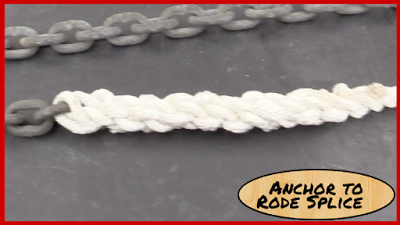When we bought DreamChaser the anchor chain was connected to an “eye” screwed into the based on the Anchor Chain locker. The survey called out an error in this stating that there was a need to have a section of line between the chain and the anchor point so in the event of an emergency it could be “cut-away”. Rather than just put in a 5 or 6 foot section we decided to add some additional length to our anchor rode by combining line (Rope) to our anchor chain.
We have quiet a bit of Anchor chain. I really need to measure it out but I have estimated that there is approximately 200-300 feet of chain so adding the additional rode will really provide us additional deeper water options if we needed it.
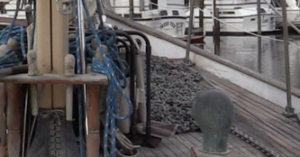 Then came the decision of how to do it. We could have just used a bowline knot or an eye splice with a swivel shackle on the bitter end of the chain, but we wanted to be all nautical and stuff. Show off our piraty skills, get it matey Arrgghh. Actually there was a much more practical reason, we wanted to be able to have the line go right over the windless and not have a large shackle and eye get caught on the windless, rollers or even the opening through the deck down into the chain locker. So we decided to braid it. There are a few references out there for how to do it but I consider Samson Rope and tool guides to be some pretty good ones that are free on the internet. Click HERE for a link to the PDF on how to do this as well.
Then came the decision of how to do it. We could have just used a bowline knot or an eye splice with a swivel shackle on the bitter end of the chain, but we wanted to be all nautical and stuff. Show off our piraty skills, get it matey Arrgghh. Actually there was a much more practical reason, we wanted to be able to have the line go right over the windless and not have a large shackle and eye get caught on the windless, rollers or even the opening through the deck down into the chain locker. So we decided to braid it. There are a few references out there for how to do it but I consider Samson Rope and tool guides to be some pretty good ones that are free on the internet. Click HERE for a link to the PDF on how to do this as well.
Using this I arranged my tools and went to work. The process is pretty simple, but I found that you have to have a marking system which I will cover below as well as a couple of tools that made this really helpful and they are in expensive. You will get your money back from the tool after just your first line compared to buying one already prepared this way.
| In the spirit of full disclosure, this is only the 2nd time I have braided line. The first time was a small seminar/class Deb and I took at the West Marine store near where we lived about 6 years ago. At that time, I am fairly certain, I bought a high dollar set of fids for splicing but be darned if I could find them. The ones I had were the samson kit that has the needle fids, the push rod and instructions along with a carrying tube. It was about $60 at West Marine and now that I needed it many years later, I will be darned if I can find any part of that kit.
With that I needed a new splicing fid and didn’t want to spend that much on a replacement kit, that lets face it, based on history will likely be lost before I need to use it again. |
I looked for other options and found a very inexpensive option that allows it to work with several different sizes of line including the thick 3/4″ 3 strand line I was working with for this anchor rode.
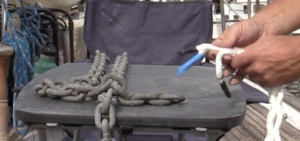 I started by laying out the chain end (the bitter end that in my case was up on deck and was going to be put down through the deck and connected in the chain locker below) on a small folding table so it was comfortable to work. In hindsight I should have just sat on the deck and worked there. The chain kept trying to slide off the table.
I started by laying out the chain end (the bitter end that in my case was up on deck and was going to be put down through the deck and connected in the chain locker below) on a small folding table so it was comfortable to work. In hindsight I should have just sat on the deck and worked there. The chain kept trying to slide off the table.
I then counted down about 5-7 strands from the end of the line and I started to untwist the line. 3 strand rope has a certain “lay” to it. if you just untwist / unwind the lines you can separate them easily. As I started to separate just the first few inches, I then taped each individual strand together. When we start to do the splicing, it is important to keep track of which strand you are using, so I like to color code the tape if possible. I happened to have some black electrical tape and blue painters tape handy, so I just used that.
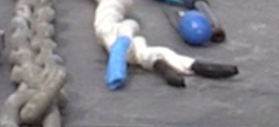 I ended up with 2 black and one blue taped end. On one of the black tape ends, I used a market to draw a line around the line indicating that the black end with the black marker line was line #1. The blue taped line would be line #2 and the black taped end with no markings would be line #3. This is really important to make sure that you don’t lose track of which strand you are working on. In this method, I wanted to have the splice be tapered so it didn’t go from single to double size in one spot. I wanted it to flow nicely over the anchor rollers and windlass gypsy.
I ended up with 2 black and one blue taped end. On one of the black tape ends, I used a market to draw a line around the line indicating that the black end with the black marker line was line #1. The blue taped line would be line #2 and the black taped end with no markings would be line #3. This is really important to make sure that you don’t lose track of which strand you are working on. In this method, I wanted to have the splice be tapered so it didn’t go from single to double size in one spot. I wanted it to flow nicely over the anchor rollers and windlass gypsy.
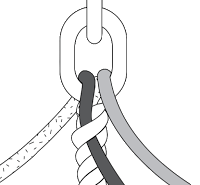 |
| Figure 1 |
The hardest part is getting the first splice correctly. Laying the section of line where the strands are untwisted heading away from you and the bitter end of the chain toward you, put the last link right at the spot where the twist is separated.
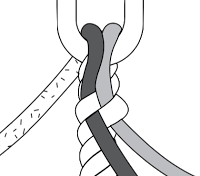 |
| Figure 2 |
You start by putting line #2 in from the back (or one way) of the last link, the other 2 lines (#1 and #3) should go from the top to the back (the opposite way). At this time you now pick a line and start by going over the first non untwisted strand and under the second one. This is hard to explain but much easier in a diagram. In Figure 1 to the left, the black line goes over the first strand and under the second. you pull it fairly tight and then move on to the next line, the Gray line then goes over the line that the black one is under, and under the next one, like in Figure 2. You then have to flip the whole lot over and do the same with the last strand.
Now it is a matter of repeating yourself as you go. I found a few things that really helped me and I hope you find these tips helpful
- Go in numerical order so you always do 3 braids and then inspect your work
- Upon inspection, your lines should come out of 3 different sides of the line at approximate equal distances from each other. If you have 2 strands on one side, you may have made an error in which line you passed over or under.
- Pull each line tight without twisting it as it passed under another line in the splice
- Continue to form the splice by pulling the lines in both directions and making sure it does not bunch up
- Mark your lines with colors or stripes to indicate #1, #2 and #3.
- Have a backup plan in the event your tape comes off if it is the only marker you have for which line your working with
In order to get a taper at the end, you want to end one line at a time. So for example if you are bracing in the order of 2, 3, 1, 2, 3, 1 and repeating, when you get near the end, you want to eliminate one of the lines and do a another round. Then eliminate another line and do another round.
 For example in the scenario above, at about the 5th round of splicing, I would change from 2, 3, 1 and then I would do 3, 1 and then the last round I would just splice strand 1.
For example in the scenario above, at about the 5th round of splicing, I would change from 2, 3, 1 and then I would do 3, 1 and then the last round I would just splice strand 1.
When you do this, you will end up with the ends coming from the SAME side of the line, but spread out a few strands down the line (not all at the same distance. When you are ready to end your splice, it should look like this with the strands hanging out. You can see logically that the one to the left is the longest and so on as each one has one more round of splices in it than its partner to the left. The last step is going to be to trim and clean up the extra stands.
| The best way to do this is to use a small amount of whipping and cut the excess line with a very sharp knife. Then use a lighter or match to singe the ends of the strands. If you are braiding a synthetic line like we are, it will melt the loose strands together and prevent them from fraying. I used tape rather than whipping and because of that my finish produce had a slightly longer bitter end coming out of the braid. It certainly works, but could have looked a bit better had I done a wax line whipping instead.I hope you found this helpful, please do check out our youtube video showing all the details as well as feeling free to share this post with others. |
I put links to the tools we used for this job as well as what I thought was a really good deal on the line that I ended up using.

